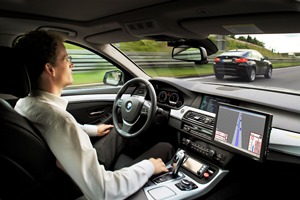The battle has started for the Internet of Vehicles

Smart connected cars made the headlines at major tech and car fests this year, from the Consumer Electronics Show (CES) in Las Vegas to the Geneva International Motor Show (GIMS) in the Swiss city.
A wide variety of automotive vehicles equipped with sensors, cameras, radars and LIDAR systems were on show, including the latest voice and facial recognition tools designed to assess drivers’ moods. Clever in-vehicle virtual reality entertainment was displayed with the help of major Hollywood studios, says Catherine Bischofberger, technical communications officer, at the International Electrotechnical Commission (IEC).
Far away from the limelight, however, a battle of epic proportions was – and still is – taking place. Two different standards are competing for the attention of regulators. These standards are relevant to what some pundits call the Internet of Vehicles (IoV) or, in other words, connected cars which can communicate both with their internal and external environments.
The IoV is expected to enable a number of applications such as collision detection, lane change warning, traffic signal control, intelligent traffic scheduling, fleet management, remote diagnostics or infotainment. By talking to each other, cars can, for example, avoid collision, one of the requirements that must be met for automotive vehicles to become fully autonomous.
Cyber security versus 5G
The DSRC (Dedicated Short Range Communications) standard enables wireless short-range information exchange between automotive vehicle on board units and roadside units. It is an amendment to Wi-Fi standards, adapted to the unique challenges of automotive applications. Its specifications are in the IEEE (Institute of Electrical and electronics Engineers) standard for wireless access in vehicular environments. DSRC is supported by a number of automotive manufacturers since it enables the implementation of an inbuilt software and hardware add-on that they can manufacture.
There is no requirement for any form of cloud or cellular infrastructure. This standard has been extensively tested and is already used in some vehicles, for instance in the GM Cadillac CTS. It is backed by the Association of Global Automakers, which includes heavyweights such as Aston Martin, Ferrari, Honda, Hyundai, Kia, Nissan and McLaren. The lack of cloud and cellular infrastructure, according to its proponents, makes vehicle to vehicle communication based on DSRC more difficult to hack than the system supported by the rival standard.

Catherine Bischofberger
The new kid on the block is the C-V2X standard. For the non-initiated, V2X technology refers to vehicle to everything communication (including vehicle to infrastructure, to pedestrians, etc…). C-V2X is a cellular-based network technology developed by the 3rd Generation Partnership Project, (3GPP) whose members include different telecoms standardisation organisations and associations which develop mobile phone protocols.
C-2VX is also backed by the 5G Automotive Association. Its founding members include Audi, BMW, Daimler, Ericsson, Huawei, Intel, Nokia and Qualcomm. C-2VX backers argue that this more recent standard is better suited to accommodate new 5G networks and all the improvements they entail.
Internationally agreed standards can help market growth
This standards clash involving the automotive and telecoms industries throws the spotlight on the need for a more global approach. IoT is revolutionising so many different areas, from electricity transmission to transport and healthcare, to name but a few. The global IoT market is still in its infancy, though, and most reports forecast spectacular growth in coming years. For the time being, however, in most IoT markets, manufacturers sell their own custom-built solutions which do not interoperate with other systems, to the detriment of the consumer. Lack of interoperability and potential standards wars could very well stifle the predicted boom.
Widely adopted and industry-backed international standards might be one of the ways forward. The International Electrotechnical Commission (IEC) and the International Standards Organisation (ISO) have formed a joint technical committee, which is producing international standards for information and technology applications, including the IoT. It also liaises closely with the International Telecommunication Union (ITU) and IEEE. Several standards have been published, such as ISO/IEC 21823-1, which defines the framework for the interoperability of IoT systems.
Standards battles are costly affairs for the industries involved. Lack of interoperability can put off consumers and the risks of eroding their trust in new technology are real. Consensus-based international standards are tools to help limit these risks in new emerging markets, such as the IoT.
The author is Catherine Bischofberger, technical communications officer, the International Electrotechnical Commission (IEC).
Comment on this article below or via Twitter @IoTGN
